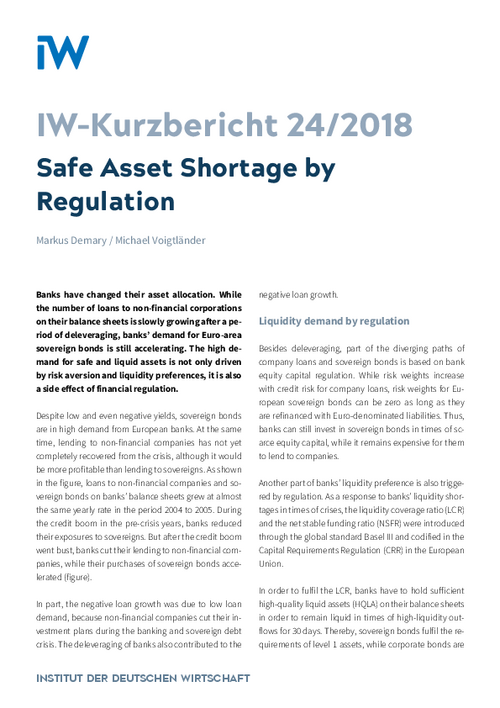Banks have changed their asset allocation. While the number of loans to non-financial corporations on their balance sheets is slowly growing after a period of deleveraging, banks’ demand for Euro-area sovereign bonds is still accelerating. The high demand for safe and liquid assets is not only driven by risk aversion and liquidity preferences, it is also a side effect of financial regulation.

Safe Asset Shortage by Regulation
IW-Kurzbericht

Banks have changed their asset allocation. While the number of loans to non-financial corporations on their balance sheets is slowly growing after a period of deleveraging, banks’ demand for Euro-area sovereign bonds is still accelerating. The high demand for safe and liquid assets is not only driven by risk aversion and liquidity preferences, it is also a side effect of financial regulation.
Despite low and even negative yields, sovereign bonds are in high demand from European banks. At the same time, lending to non-financial companies has not yet completely recovered from the crisis, although it would be more profitable than lending to sovereigns. As shown in the figure, loans to non-financial companies and sovereign bonds on banks’ balance sheets grew at almost the same yearly rate in the period 2004 to 2005. During the credit boom in the pre-crisis years, banks reduced their exposures to sovereigns. But after the credit boom went bust, banks cut their lending to non-financial companies, while their purchases of sovereign bonds accelerated (figure).
In part, the negative loan growth was due to low loan demand, because non-financial companies cut their investment plans during the banking and sovereign debt crisis. The deleveraging of banks also contributed to the negative loan growth.
Liquidity demand by regulation
Besides deleveraging, part of the diverging paths of company loans and sovereign bonds is based on bank equity capital regulation. While risk weights increase with credit risk for company loans, risk weights for European sovereign bonds can be zero as long as they are refinanced with Euro-denominated liabilities. Thus, banks can still invest in sovereign bonds in times of scarce equity capital, while it remains expensive for them to lend to companies.
Another part of banks’ liquidity preference is also triggered by regulation. As a response to banks’ liquidity shortages in times of crises, the liquidity coverage ratio (LCR) and the net stable funding ratio (NSFR) were introduced through the global standard Basel III and codified in the Capital Requirements Regulation (CRR) in the European Union.
In order to fulfil the LCR, banks have to hold sufficient high-quality liquid assets (HQLA) on their balance sheets in order to remain liquid in times of high-liquidity outflows for 30 days. Thereby, sovereign bonds fulfil the requirements of level 1 assets, while corporate bonds are level 2 assets, which have an upper cap of 40 percent of the stock of HQLA. Moreover, level 1 assets are not subject to a haircut, while level 2 assets are subject to a haircut of at least 15 percent (BCBS, 2013).
The NSFR should prevent excessive maturity mismatches between the asset and the liability sides of banks’ balance sheets. Banks that relied to a large degree on short-term money market funding now have to either adjust their liability sides towards longer maturities, or adjust their asset sides towards more liquid investments. In the calculation of the NSFR, sovereign bonds are treated with a 5 percent required stable funding factor (RSF), while loans to companies are treated with an RSF of a least 50 percent (BCBS, 2014).
Financing shortages for long-term investments
When regulation triggers an increase in the liquidity preference of banks, financing shortages for long-term investments can arise.
Within the European bank-based financial market system, small and medium-sized enterprises (SMEs) rely to a large degree on bank loans for financing their investments. The effects of the LCR and NSFR on the access to finance for these companies might be more severe compared to SMEs in a market-based financial system, such as in the US, where SMEs are more experienced with other forms of financing, ranging from private equity to the issuance of corporate bonds.
However, liquidity regulation can also cause banks to refrain from financing other long-term projects, such as real estate and infrastructure projects.
Safe asset shortages can arise
The high demand for liquid financial assets can also have macroeconomic consequences.
According to Caballero and Farhi (2014, 2017), high demand for liquid financial assets can lead to safe asset shortages, as long as there is a low supply of safe assets. If this were the case, the demand for liquid financial assets would drive down the risk-free interest rate. If the hypothetical risk-free interest rate declines below the zero lower bound on interest rates, the economy will experience a so-called safety trap, which is a permanent shortfall of aggregate demand. Through the slack in the economy, it will become stuck in a deflationary spiral.
However, the supply of HQLA falls short of demand. Caballero and Farhi (2014, 2017) predicted a decline in safe assets from 37 percent of global GDP in 2007, to 18 percent of global GDP in 2011. Most of the decline was due to rating adjustments in US mortgage-backed securities, which were regarded as safe assets before the global financial crisis, and the downward rating of Eurozone sovereign bonds, which were also regarded as safe assets before the banking and sovereign debt crisis.
Regulation distorts capital flows
High demand for HQLA can also increase in times of crisis when investors withdraw their capital from crisis countries and fly to safe havens. In the Eurozone, investors' flight to safety and liquidity led to a very strong demand for safe bonds, such as the German Bunds, resulting in their yields temporarily turning negative.
These destabilizing capital flows can be amplified when there is a huge demand for, and short supply of, HQLA.
Time to rethink financial reform
Liquidity preference can be eased either by shaping regulation in such a way that banks will lend less to governments and more to firms, or by a larger supply of safe assets. Both solutions require a reform of banking regulation.
Lower demand for HQLA would result from a risk-based capital requirement for sovereign bonds, as well as by applying the large exposure limit, whereby a bank may lend a maximum of 25 percent of equity to a single borrower, to sovereign bonds.
Safe asset supply can be boosted by a revival of securitisation. The European Commission’s proposal for simple, transparent and standardised (STS) securitisations was intended to revive confidence in European securitisations, but the markets have not yet revived. Practitioners refer to the high legal uncertainty surrounding the qualification of securitisations as STS (Demary/Bechtold, 2016). Moreover, STS are currently less attractive to investors, since the capital requirements for STS are too tight in relation to their default rates, while investor demand for sovereign bonds with the same default rate as an STS securitisation is in part higher because of the lower capital requirement for sovereign bonds.
Summing up, regulation distorts incentives for banks. Instead of lending to corporations in order to promote economic growth, as intended by monetary policy, banks are increasingly dependent on the solvency of states, which might turn out to be an obstacle for necessary reforms in the Eurozone structure. Thus, a reform of regulation should be tackled soon.

Markus Demary / Michael Voigtländer: Safe Asset Shortage by Regulation
IW-Kurzbericht


Fin.Connect.NRW-Fachveranstaltung: Banken werden klimaneutral – Welche Konsequenzen ergeben sich für Unternehmen?
Die globalen Megatrends Demografie, Dekarbonisierung, Digitalisierung und De-Globalisierung treffen auf die Industrieregion NRW. Um den Strukturwandel erfolgreich zu bewältigen, müssen die Unternehmen in NRW jährlich 98 Mrd. Euro in Dekarbonisierung und ...
IW
Wie hoch sind die Investitionsbedarfe in die klimaneutrale und digitale Transformation in NRW?
Für die Finanzierung der klimaneutralen und digitalen Transformation müssen in NRW jährlich mindestens 100 Mrd. Euro investiert werden. Dies ergab diese Meta-Analyse der vorhandenen Studien zum Investitionsbedarf in die Digitalisierung. Dabei fallen allein zur ...
IW